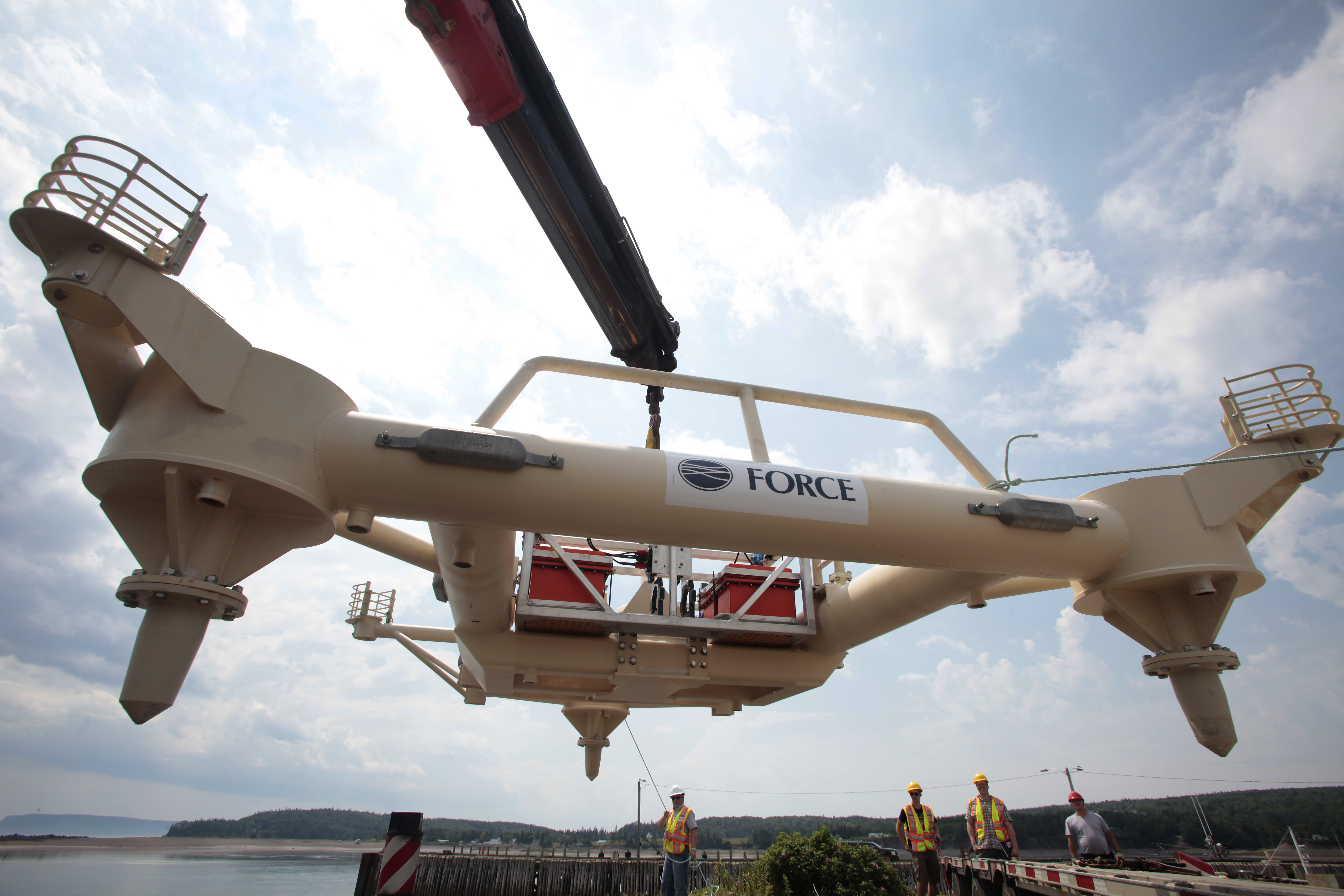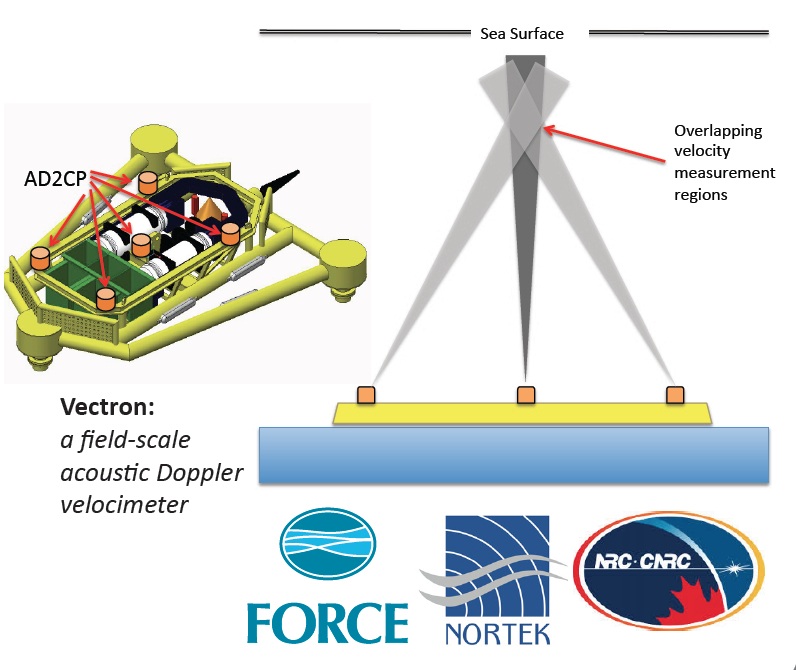Overview
If in-stream tidal energy development is to grow to larger-scale, it must be environmentally safe and sustainable. FORCE is dedicated to working with many partners to better understand if in-stream tidal technology can play a role in Canada’s energy’s future.
Safety
Ensuring the safety of human and marine life is a critical priority. In-stream devices:
Follow a careful installation process, one device at a time
Are continuously monitored while under operation, and can be removed if necessary
Turn slowly, and allow water to flow freely through and around them (in contrast to a dam)
Scale
Maintaining small, demonstration-scale growth supports environmental safety. A single turbine in the Minas Passage is:
Roughly 1/1000th of the cross-sectional surface area of the Minas Passage (i.e. 99.9% of the cross-section is unoccupied)
Relative to the Minas Passage sea floor, roughly comparable to a tennis ball on a tennis court
Unlikely to present significant environmental effects (sensors will be positioned to detect effects on marine life, if any)
International Research
In-stream devices have been installed in a number of locations around the world, including the United Kingdom, France and the Unites States. To date, international research studies have not found a single recorded instance of a collision between marine mammals, fish, turtles or seabirds and a marine in-stream tidal turbine[1]. Findings indicate that:
Fish and marine mammals generally avoid turbines[2]
Zooplankton passing through a turbine remain unharmed[3]
The world’s longest running in-stream turbine – the 1.2 megawatt SeaGen unit in Strangford Lough, Northern Ireland – has had no significant impacts on marine life.[4]
Environmental Monitoring
Since 2009, the Fundy Ocean Research Center for Energy (FORCE) has been conducting an environmental effects monitoring program (EEMP) to better understand the natural environment of the Minas Passage and the potential effects of turbines as related to fish, seabirds, marine mammals, lobster, marine noise, benthic habitat and other variables. All documents are available to the public at: http://fundyforce.ca/environment/monitoring/
FORCE’s most recent monitoring program was developed in consultation with SLR Consulting (Canada), and strengthened by review and contributions by national and international experts and scientists, provincial and federal regulators, and FORCE’s environmental monitoring advisory committee (EMAC), which includes representatives from scientific, First Nations, and fishing communities. The EEMP will:
monitor the environmental effects of operating turbines
focus on five subject areas: lobsters, fish, marine mammals, marine seabirds and marine noise
be adaptive, based on monitoring results and input from regulators and EMAC
Fish monitoring
Fish monitoring measures changes in fish distribution and behaviour, and assesses the probability of fish encountering a turbine.
Marine Mammal monitoring
Marine mammal monitoring detects changes in the distribution of the harbour porpoise in relation to operational in-stream turbines.
Lobster monitoring
Lobster monitoring measures whether the presence of a turbine affects the number of lobster entering traps. Commercial lobster traps are used to compare catch volumes inside and outside the turbine test area.
Marine noise monitoring
Marine noise monitoring measures both ambient noise and noise generated by in-stream turbines, for prediction of effects on marine life.
Seabird monitoring
Seabird monitoring captures site-specific species abundance and behavior data to determine whether a turbine displaces seabirds from habitual waters, and to identify any changes in behaviour.
Control
Each technology deployment at FORCE is under regulatory control:
Developers are limited under provincial feed-in tariff regulations to a total of 22 megawatts (equal to 2-3 tidal energy conversion devices per developer)
Monitoring plans for each developer are reviewed by provincial and federal regulators and EMAC
The province may impose additional conditions or order devices removed if necessary
Sensor Program
In 2012, FORCE began the Fundy Advanced Sensor Technology (FAST) program in an effort to enhance environmental data capture in extreme high flow environments.
FAST includes an array of underwater monitoring platforms that can connect to Ocean Networks Canada’s online data management system. The platforms use a variety of onboard sensing equipment to capture data for assessments of:
Current speed and turbulence
Marine life activity
Ambient noise (includes marine species)
Water quality
Fundy Advanced Sensor Technology
(FAST) Program
The tidal flow through the Minas Passage boasts 14 billion tonnes of water, moving at speeds in excess of five meters per second. Understanding this powerful environment is critical to successful turbine design, environmental effects monitoring, and ultimately unlocking Fundy’s enormous energy potential.
FORCE created the Fundy Advanced Sensor Technology (FAST) program to advance efforts to monitor and characterize the FORCE site.
FAST combines both onshore and offshore monitoring assets. A focus of FAST has been the development of two underwater monitoring platforms. The platforms use a variety of onboard sensing equipment to capture data from the Minas Passage, including:
Currents and turbulence
Marine life activity
Noise levels
Seabed stability
The entire FAST program includes subsea data collection, subsea data cable installation, shore-based radar and meteorological equipment, as well as platform fabrication, instrumentation, and deployment. FAST is supported by Encana Corporation, Natural Resources Canada, and FORCE developers.
Subsea Equipment
Reliable site data is critical to all aspects of in-stream tidal energy development, including the design, installation, and maintenance of turbines, as well as understanding and measuring any effects on the marine ecosystem.
To better understand the site, FORCE has begun to integrate data from a number of subsea monitoring systems, including two FAST platforms. These instrument platforms provide a clearer, moment-by-moment picture of what’s happening under the water.
FAST-1, at 4.5-tons and 4-metres in length, is designed for frequent deployment and recovery to enable instrument testing at any location throughout the Bay of Fundy.
FAST-2, at 650 kilograms and 3-metres in length, is designed for subsea data cable connection, enabling access to real-time data from the Minas Passage.
The FAST subsea platforms gather data on various environmental characteristics, including:
Current profiles
Fish abundance
Depth
Temperature
Salinity
Particulate matter
Turbulence
Zooplankton abundance
Sea floor stability
Conductivity
Tide
Acoustics (passive noise detection)
The platforms are also supported by two subsea data cables, the first of which was installed in December 2013 – in a blizzard!


Shore-based Equipment
FORCE has integrated shore-based monitoring systems at the Visitor Centre. The monitoring systems include instruments such as X-band radar, meteorological station and tide gauge offshore. These instruments provide a multidimensional understanding of our real-time operating environment.
FORCE has launched a new collaboration with Ocean Networks Canada (ONC) to support the FAST program by enhancing the accessibility of its data to the public, scientists and developers around the world. Our onshore data is already accessible online, featuring a series of time lapse graphs of information including wind speed and direction, air pressure and temperature, relative humidity, solar radiation, absolute pressure, and water temperature and depth.
See live online data
The Vectron
Advancing the Science of Tidal Power
Project Overview
FORCE, in partnership with Nortek Scientific, a Canadian centre of excellence in acoustic Doppler processing, is developing the world’s first instrument to accurately measure turbulence throughout the water column – called a Vectron.
A leap forward in site characterization, the Vectron generates high fidelity measurements of turbulence through turbine hub height. These measurements include turbulence intensity, time and length scale distributions – all identified as key contributors to turbine performance and loading.
Traditional acoustic Doppler current profilers (ADCPs) use diverging beams to approximate the velocity, but averaging across the beams filters out much of the turbulence information. Acoustic Doppler velocimeters (ADVs) use converging beams to measure turbulence accurately, but have very limited range. The Vectron will combine the range of the ADCP with the accuracy of the ADV.
Phase one of Vectron development: beams from three acoustic Doppler profilers converge on a single point to measure water velocity in a testing tank at Dalhousie University, Halifax, NS
Breakthrough
The Vectron represents a significant international scientific achievement – the first continual, reliable measurement of turbulence through the water column. The Vectron provides critical information for industry – information that investors and developers will use to construct, deploy and maintain their turbines and marine infrastructure. This data is critical to success not only in the challenging conditions of the Bay of Fundy, but at high flow sites worldwide.
Development
FORCE is currently developing an underwater monitoring platform designed to deploy and recover instruments in high flow environments: the FAST platform. FAST provides the perfect opportunity to develop and test the Vectron. FORCE and Nortek Scientific will partner to provide hardware, firmware, software, turbulence processing, platform mounting, and deployment.

Sources:
[1] Annex IV 2016 State of the Science Report: Environmental Effects of Marine Renewable Energy Development Around the World (2016). Copping, Sather, Hanna, Whiting, Zydlewski, Staines, Gill, Hutchison, O’Hagan, Simas, Bald, Sparling, Wood, and Masden.
[2] In-situ ecological interactions with a deployed tidal energy device; an observational pilot study (2014). Broadhurst, Barr and Orme.
[3] Assessment of Zooplankton Injury and Mortality Associated With Underwater Turbines for Tidal Energy Production (2013). Schlezinger Taylor, and Howes
[4] SeaGen Environmental Monitoring Programme Final Report (2011) Keenan, Sparling, Williams, and Fortune.